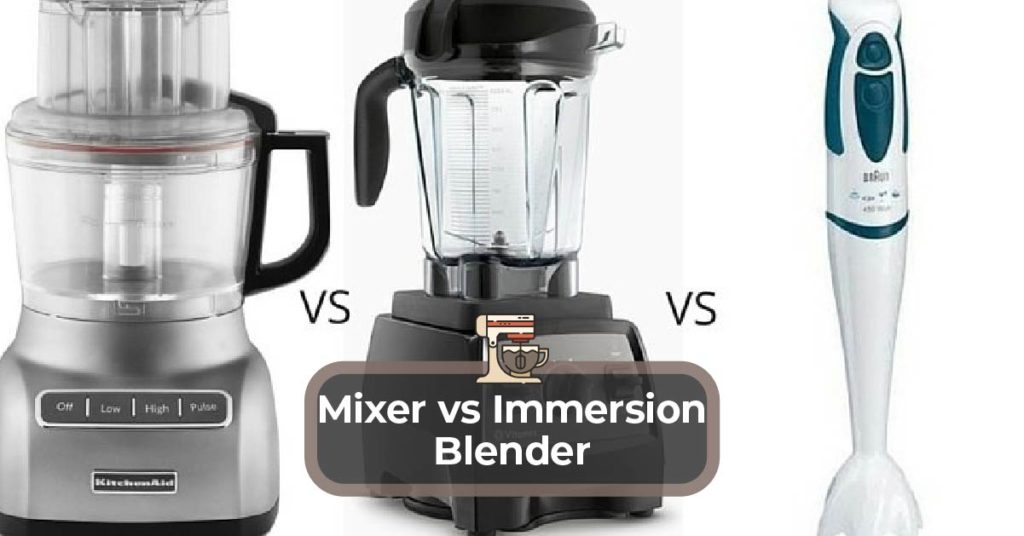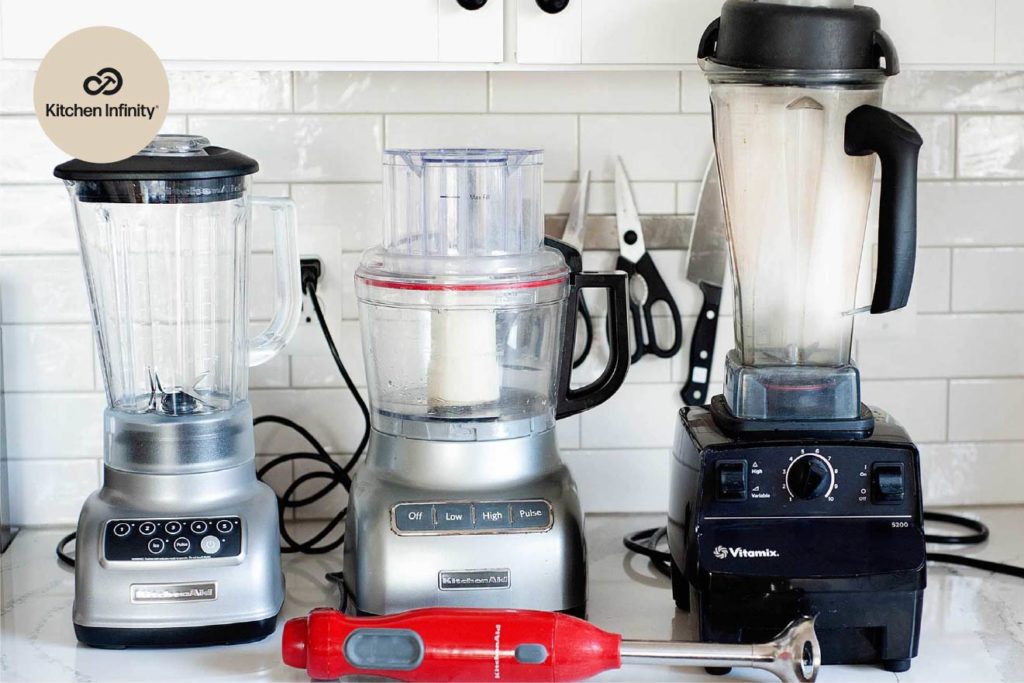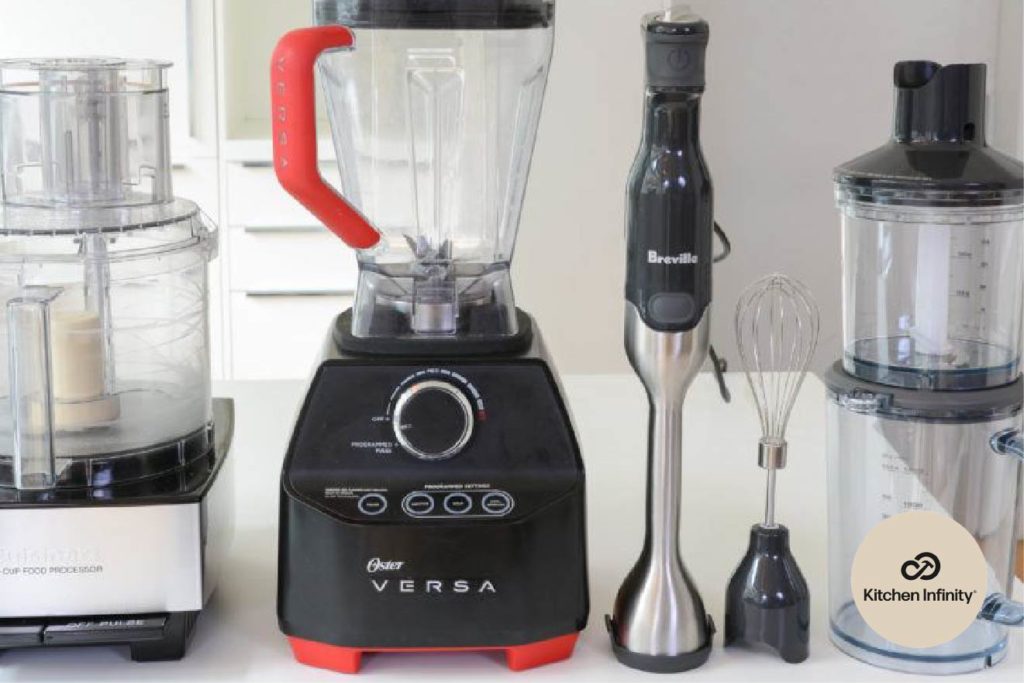
Jump to Section
Mixers and immersion blenders are some of the most versatile kitchen appliances for preparing some of our favorite foods.
They save us a lot of time and relieve us from performing some tedious tasks. They even have overlapping duties. However, they have different functions; hence the essence of a mixer vs immersion blender debate.
To help you decide which of these appliances will be more useful to you, we’ll explore the immersion blender vs mixer debate.
Let’s find out the differences between a mixer and an immersion blender.
What Are the Main Differences Between A Mixer and An Immersion Blender?
The main difference between a mixer and an immersion blender is their functionality.
A mixer is a powerful countertop appliance for kneading dough or mixing recipes such as cake batter while an immersion blender is a handheld appliance for blending solid ingredients into liquid, purees, or soups.
The second main difference between a mixer and an immersion blender is in their design.
Stand mixers have beaters or whisks that can be attached to mix recipes while immersion blenders have sharp chopping blades for cutting ingredients into smooth pasty results.
To better understand how these two devices work, let’s explore them individually.
What is a mixer? A mixer (also called a stand mixer) is a versatile kitchen appliance that comes fitted with beaters and other attachments for mixing, knocking, and kneading ingredients.
So the primary function of stand mixers is baking; that is they’re used for performing tedious baking tasks such as whipping creams, mixing cake batters, and kneading dough.
Aside from baking, the versatility of mixers ensures they can whisk eggs, prepare meat, make pasta, and process both thin and thick juices. However, one thing mixers can’t do is break down solid foods into liquid.
As a rule of thumb, if your task is to combine multiple ingredients into a mixture (without breaking down solids), the tool to use is a mixer.
Kitchen mixers are very powerful when mixing ingredients because they use a technique referred to as “direct drive” to produce more torque to run the motor.
Also, their whisk-like beaters are interchangeable, so you can replace them with dough hooks; this makes mixers very versatile in performing a range of kitchen tasks.
What is an immersion blender? An immersion blender also called a stick or hand blender is a versatile handheld appliance for crushing solid food items into a smooth paste (liquid or powdery).
Hand blenders have very sharp blades and powerful motors that can liquefy ingredients; hence, they’re used for crushing ice; cutting fruits into purees; preparing soups and sauces; blending vegetables into smoothies and dips, etc. Every handheld immersion blender comes with a permanent blade that you can’t replace with another tool.
A hand blender is a space-saving alternative for a countertop blender since it doesn’t have a big jar for processing recipes. Instead, you’ll have to dip your immersion blender into the bowl or pot containing the ingredients you want to process.
What are the advantages of a mixer over an immersion blender?
The advantages of a mixer over an immersion blender are that it’s a versatile and powerful appliance that’s great for mixing ingredients.
Great for mixing ingredients
When compared to immersion blenders, mixers are great for combining dry ingredients.
And their specialty is baking; so when you want to bake bread, cake, or cookies, the best kitchen equipment to use is a mixer.
While blenders can cut and mix pulpy recipes such as tomatoes and peppers to yield salsas or blend vegetables and fruits to make smoothies and fruit juices. They’re not great for beating or whisking dry ingredients.
Comfortable to use
When compared to hand blenders, mixers are more comfortable to use.
First, stand mixers are countertop appliances with beaters and other attachments for mixing, whipping, whisking, and beating recipes. While working, they sit on the countertop, and you can load your ingredients into its container so it can process them. But with an immersion blender, you’ll have to dip and move it around the container all through the blending process.
Even using a hand mixer is more comfortable than using a stick blender as you can hold the latter in one position instead of moving it around.
More powerful
When compared to hand blenders, mixers come with more powerful motors than immersion blenders. Hand mixers are even more powerful than hand blenders of the same quality.
Typically, the power of stand mixers begins from 500W while immersion blenders are around 250W.
As a result, mixers are very efficient at mixing foods. They also come with varying speed settings since mixing some recipes like buttercream icing requires less speed than mixing sugar and egg whites to make a meringue.
Better versatility
Mixers are more versatile than blenders. This is because there are other attachments that you can interchange with the whisk-like beaters.
For example, you can replace the whisk with dough hooks for kneading pizza dough. Also, mixers can blend and mix recipes that require light blending such as milkshakes, sauces, soups, chocolate, and other drinks.
Conversely, stick blenders come with sharp blades that you can’t interchange with other tools (although they come with a few accessories).

What are the advantages of an immersion blender over a mixer?
The advantages of an immersion blender over a mixer are that it’s an appliance that’s great for liquefying solid foods, easy to use, and saves countertop space.
Great for blending solid foods into liquids
When compared to a mixer, an immersion blender is great for turning solid foods into liquid.
So when the result is going to be juice or you want to turn tomatoes into sauce or salsa, the tool to use will be an immersion blender. This is because stick blenders come with sharp blades that can cut through fruits, vegetables, and other ingredients to make healthy juices, purees, smoothies, milkshakes, and soups.
On the other hand, stand mixers aren’t optimized to make liquid out of solid recipes.
Easy to use
When comparing an immersion blender to a mixer, an immersion blender is easier to use.
All you have to do is immerse your hand blender into the container or pot containing the recipes and blend away.
Also, immersion blenders are lightweight, so you can take them anywhere and dip them into pots containing hot liquids to blend the mixture without fear of them burning or the liquid splattering.
Saves countertop space
Unlike stand mixers and stand blenders that take up countertop space, immersion blenders are great for small kitchen owners with limited countertop space.
Immersion blenders are also portable; so you can use them on the kitchen counter and toss them on the cabinet’s shelf. They’re also perfect for camping trips since they require little storage space and are portable.
Cheaper price
When compared to a stand mixer, an immersion blender is a cheaper appliance. This is because stand mixers can perform more kitchen tasks than a handheld immersion blender. Also, hand blenders aren’t as powerful as stand mixers.
An immersion blender costs between $20 and $300, while the price for a mixer ranges between $20 and $900.
Easy cleanup
Unlike standalone appliances, handheld devices such as hand blenders are easy to clean up.
This is because a stand mixer has many moving parts that you may have to disassemble. Secondly, some of the parts aren’t dishwasher-safe. Conversely, a stick blender only has its blades and wand.
Which One is more Usable in the Kitchen between A Mixer and An Immersion Blender?
A kitchen mixer is more versatile than an immersion blender. This is because it comes with attachments that make it great for performing more kitchen tasks than a hand blender. While mixers can be used for baking and cooking generaly, immersion blenders are only used for making smooth soups, juices, and purees out of fruits and vegetables.
And if you’re asking, “Is a mixer the same as an immersion blender?” No, they’re different appliances.
Kitchen mixers are appliances with whisk-like beaters mostly used for mixing fats, sugars, and other baking recipes. While immersion blenders are lightweight, handheld appliances for breaking down solid foods to make soups, stews, smoothies, milkshakes, and purees.
What foods can you make with a mixer?
The main functions of mixers are whisking, whipping, beating, and kneading ingredients. Aside from baking cakes, these are some of the creative ways you can your mixer;
- Homemade ice creams
- Pretzels
- Butter
- Pizza dough
- Pasta
- Chocolate soufflé
- Biscuits and cookies
- Shredded cooked chicken
- Bread dough
- Dumplings
- Playdough
- Pie crust
- Donuts
- Shredded beef
- Muffin
- Peanut butter
- Granola bars
- Batters: brownie, meringue, cupcake, cake batter
- Whipped cream
- Cinnamon rolls
- Brown sugar
- Scones
- Bread: white sandwich, banana, whole wheat, and pumpkin bread
- Shredded pork
- Egg salad
- Meatloaf
- Potatoes
- Scrambled eggs and egg salad
Here are other different uses of mixers.
What foods can you process in an immersion blender?
Immersion blenders are used for liquifying, crushing, pureeing, and chopping food items. They’re great for breaking down vegetables, fruits, and other foods into delicious smoothies, milkshakes, soups, and purees.
Here are some of the creative uses for an immersion blender;
- Pesto
- Smoothies: yogurt and kale smoothies
- Bread: chocolate banana bread and zucchini bread
- Whipped cream
- Daiquiri
- Salsa
- Cauliflower puree
- Salad dressing
- Sorbet
- Pudding: peanut butter and vanilla chia seed pudding.
- Protein shake
- Milkshake
- Soups: tomato bisque, broccoli, potato, and butternut squash soup
- Sauce: Tomato, hollandaise, pizza, and cheese sauce
- Cauliflower pizza crust
- Pancake and waffle batter
- Aioli
- Peanut butter
- Condiments: homemade mayonnaise, ketchup, whipped feta dip
- Sweets: applesauce and pistachio cream
Can a mixer and an immersion blender be paired together in a kitchen?
Yes, you can pair a mixer and an immersion blender in a kitchen as they have different functions.
Mixers come with attachments for baking cakes, biscuits, and other confectionery. On the other hand, immersion blenders come with sharp blades for cutting and chopping veggies, fruits, and other food items to make soups, dips, smoothies, purees, etc.
And while stand mixers can make a few soupy recipes, it’s not their specialty, so you won’t get a result as good as those made by immersion blenders. Here's a guide on how to use mixers.
What are the instances where you can use a mixer and an immersion blender together?
While you’re using your stand mixer to mix the recipe for your cake batter, you can use your hand blender to blend some fruits or veggies for your smoothies or fruit juice.
What are the instances where a mixer and an immersion blender should never be used together?
There are tasks that both mixers and immersion blenders can perform; they include shredding chicken and churning butter. For these tasks, you can use either a mixer or an immersion, but not both.
What to Consider when Buying A Mixer or An Immersion Blender?
Before getting a mixer or an immersion blender, here are the factors you should consider to pick the right appliance.
What type of food processor should I get?
There are two types of kitchen mixers; a hand mixer and a stand mixer.
Hand mixers are portable and cheaper than stand mixers. Since they’re handheld, they don’t take up countertop space. However, they’re not very powerful and they require a bit more work.
Stand mixers are more powerful, versatile, and expensive than hand mixers. They’re also more convenient to use as you can set and leave them to mix your recipes while you attend to other things. However, they take up counter space and are more difficult to clean.
On the other hand, immersion blenders are handheld versions of stand blenders; they also don’t take counter space like stand mixers, and they’re cheaper. But they aren’t as versatile as kitchen mixers.
How does my cooking needs affect my choice?
Your cooking needs will determine the kind of appliance you’ll use.
If you bake bread or cookies in large quantities or you cook for a lot of friends once in a while, you’ll have to go for a powerful model that can make big batches of cookies at a time.
Also, mixers come with accessories that can allow you to mix a variety of items. For example, you can be able to make meatballs, pasta, butter, ravioli, etc., using the right mixer attachment.
Immersion blenders may be powerful but they’re best suited to processing soft foods like soups, spreads, and sauces. And if you intend on crushing ice, the motor of immersion blenders isn’t powerful enough for such tough tasks.
How powerful should my appliance be?
Kitchen mixers are powerful appliances but not all are powerful enough to generate the kind of speed to mix tough ingredients.
Mixers have speed settings ranging from 3 to 12 speed settings. A 3-speed setting mixer may be ok for some bakers but if you prefer to bake with more precision, go for a model with more speed settings.
Furthermore, kitchen mixers with 500 to 750 watts are good enough for the average kitchen.
Immersion blenders usually have wattage ranging from 150W to 600W. However, you can go for models with wattage ranging from 200 to 400 watts as they’re powerful enough to carry out most domestic blending functions.
What attachments should come with my food processor?
Both mixers and immersion blenders come with attachments and accessories.
For most mixers, here are the attachments that should come with your package;
- Dough hook for kneading bread and pizza dough
- Flat beater for making cake batters and mashed potatoes
- Wire whip for making whipped cream and meringue
In your hand blender package, you may get the following;
- a star blade head (s-blades) for making soup, sauces, and dressings
- a whisk head for mixing cake recipes
- mini chopper for light chopping tasks
- a frothing blade head for frothing milk
- a masher for mashing potatoes
- a beaker (a container for blending recipes).
How much should I spend on a food processor?
While there are many appliances to buy from, some don’t come with the features you need, and some features of some high-end mixers or immersion blenders may be superfluous.
You can get a good stand mixer for around $200 and $300, and hand mixers cost less than $100. While for hand blenders, a $60 model will be quality enough to carry out your kitchen tasks. However, expect to pay around $200 for a high-end model.

What Are the Best Brands for Mixers?
Not all kitchen mixers are efficient: these are the five best brands making the best mixers; KitchenAid, Hamilton Beach, Cuisinart, Panasonic, and Sunbeam.
KitchenAid
When it comes to stand mixers, KitchenAid is the best you can get. They have beautiful designs and they’re durable. They also come with lots of attachments and accessories. And their units have lots of positive reviews. However, they’re expensive.
Hamilton Beach
Hamilton Beach is one of the top brands making some of the best kitchen mixers. However, their units aren’t as durable or functional as the other mixer makers on this list. And what sets them apart is their cheap prices.
Cuisinart
Cuisinart is one of the best brands making the best mixers. Their appliances are mid-priced and fast when mixing recipes. However, their appliances seem to have problems making bread dough.
Panasonic
Panasonic is another reputable brand making some of the best home appliances. Their mixers are fast in mixing ingredients, and they’re priced moderately.
Sunbeam
Sunbeam is one of the mid-priced alternatives to KitchenAid mixers. While they’re very functional, they can’t perform heavy-duty tasks such as kneading dough. They’re also not very durable as they’re made of plastic.
What Are the Best Brands for Immersion Blenders?
The five best brands making the best immersion blenders are KitchenAid, Braun, Hamilton Beach, Vitamix, and Cuisinart.


